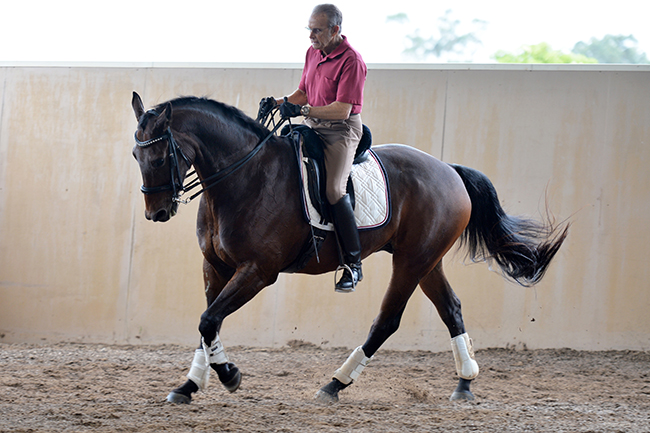 Story by Chris Hector and photos by Roz Neave
Story by Chris Hector and photos by Roz Neave
The late Miguel Tavora had a rare combination of talents.. A teacher who was happy to get on the pupil’s horse and ride, and a rider who had a rich theoretical knowledge of the classics of equestrian art – aided in no small way by his ability to read the classics in English, French or Portuguese. This article demonstrates the breadth of his knowledge and what a subtle teacher Miguel was…
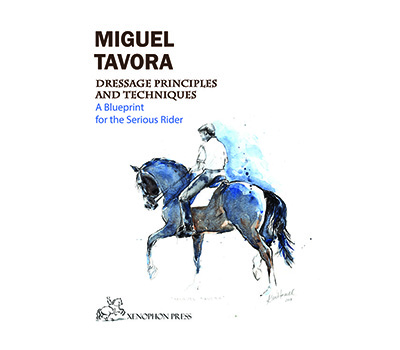
Shortlly before he died, Miguel’s book Conceitos Equestres – Princípios e Técnicas was translated (by Miguel) into English and published by Xenophon Press – they have copies.
I asked Miguel about his book…
“From the beginning I was following the training scale: the work on the lunge, the work on the ground, the breaking in, and what I call ‘the familiarization’ of the rider and the horse, and then to the scale, relaxation and rhythm, balance, impulsion, contact, straightness, lightness and collection. I talk about riding through the lateral work to collection, then the flying change, pirouettes, passage and piaffer.”
Is your version of the training scale, the same as the modern German training scale?
“The training scale is confusing if you look at it by itself. If you look at the diagrams, because of the name, Training Scale, we tend to think we start here, then go there, and then there, and that can lead to errors in training, because all of the elements are a part of collection, and collection, to some degree, even applies to a very young horse.”
“You can start straight away with the shoulder-in, that is not damaging the horse: the horse can think a little shoulder-in. You can make a shoulder-in with collection, and shoulder-in without collection, so the horse can start to think about a little bit of collection.”
“The important thing is not to be confused by these principles. First we start by rhythm, and after that losgelassenheit, which is often a misunderstood term, it is not only looseness, but also some degree of suppleness. Then you can’t have rhythm without having some degree of relaxation. If the horse is not relaxed, if it is not to some degree balanced, of course a balance in keeping with the horse’s stage of training, more a horizontal balance than the vertical balance of collection, but if you have no balance, you cannot have rhythm. It makes no sense to me, to have rhythm on the first part, then we go to contact and acceptance of the bit – but I don’t think you can’t have anything without looseness.”
“When the horse starts to accept and understand your aids, and your aids flow through, then we have lightness. But of course for the aids to pass through, the horse has to be balanced, to be loose, it needs to go forward, it needs to go comfortably, and be confident in the work. Most important is that the horse is relaxed and forward because then the balance is there for sure. Then he has time to understand our aids and now our aids pass through and are accepted. Again even though you are looking for that from the beginning, it comes later on the training scale, when you are sure that when you make a half halt, and by that half halt you achieve the result that you want.”
more on the training scale follows
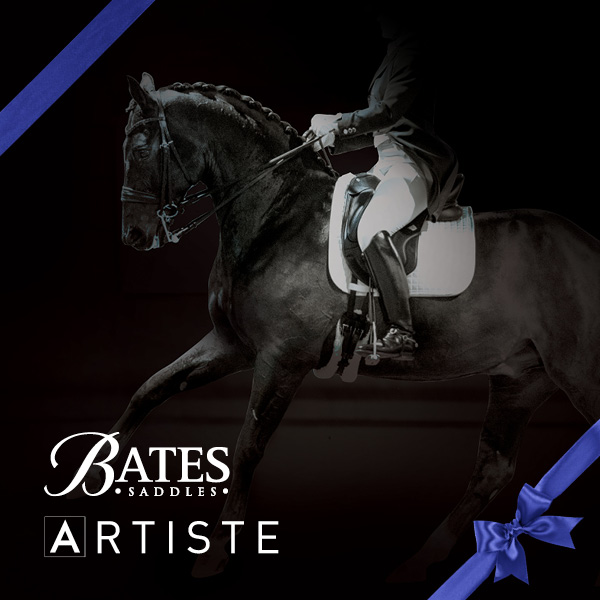
It is more a matter of emphasis isn’t it – not this followed by this by this, more this concern is predominant at this stage in the horse’s training, or at this stage in the working session…
“Exactly. But in the beginning you must have all these elements on your mind so that you know that they are connected, and that you can’t have one without the other. You can’t achieve some degree of looseness or of rhythm, without your aids triggering that, and that is already the horse understanding the aids.”
“Then we come to contact, the contact appears – and this for me is very important. It is very easy to get a contact, any jockey when he gallops, he pulls back and the horse pulls on the other side, and you have contact. That is a contact that you look for directly, that is wrong from my point of view. Contact is something you have to feel happens, because the horse moves forward, because the horse is in balance, because the horse is comfortable, he establishes and accepts the contact with the reins and with the hand because there is no reason not to. That contact has to be firm, it needs to be soft, because if it is not soft, we don’t know if he is heavy or not, but has to be firm and has to be there all the time. What is important to understand is that you don’t look directly for the contact, you have to realize that the contact is the result of your riding position being correct, your horse moving on the correct balance with the correct impulsion, and then the contact happens.”
“The horse doesn’t seek contact, the horse doesn’t seek anything. What is seeking? It is like the horse wants to go forward. No, the horse has to be ready to go forward. If the horse wants something, it is because his instinct has told him to do it, and if he does it when you don’t want it, that’s a problem. For example if he wants to extend the trot when you want to collect the trot, then you are in big trouble. If you want a degree of impulsion to make a canter pirouette, that is different from the horse wants to have an impulsion to extend the canter, then resistance appears. Not want, the horse has to be ready. The horse and rider are established, and the horse accepts the contact – firm but in a soft way. When I say soft, that is the opposite of heavy, light contact, so that the contact is not dead. I know that if I make a bend, he bends, if I make a transition, he accepts the transition, that is what I call soft. Straight away ready to obey. He doesn’t seek anything, he has to accept.”
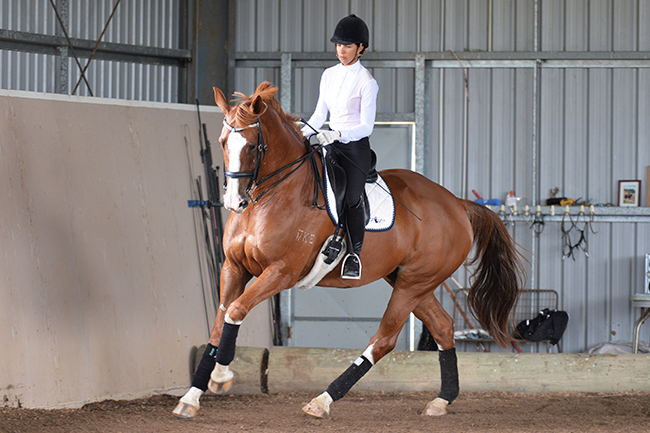
Our model, once again, is Miguel’s incredibly talented pupil, Grace Kay riding Karingal Jamirqui, the horse she has taken all the way to FEI level…
It all starts before you get on the horse’s back, in lunging?
“Absolutely. The lunge is the way to introduce yourself to the horse, to establish the first communication of your aids. With the lunge and the whip, we make the horse go forward, you make the horse slow down, lengthen the stride, come to you, make a little bend. Then later on when you hop on the horse, he associates the feelings, when you break the horse the correct way, there is somebody on the ground, and the rider is on top of the horse. The trainer says, trot on, and shows the whip the way he did without the rider, and at the same time, the rider uses his legs to make the horse move forward, and the horse associates the whip that he knows, with the leg that he didn’t know, and there you are, the horse associates, and learns to respond to your legs.”
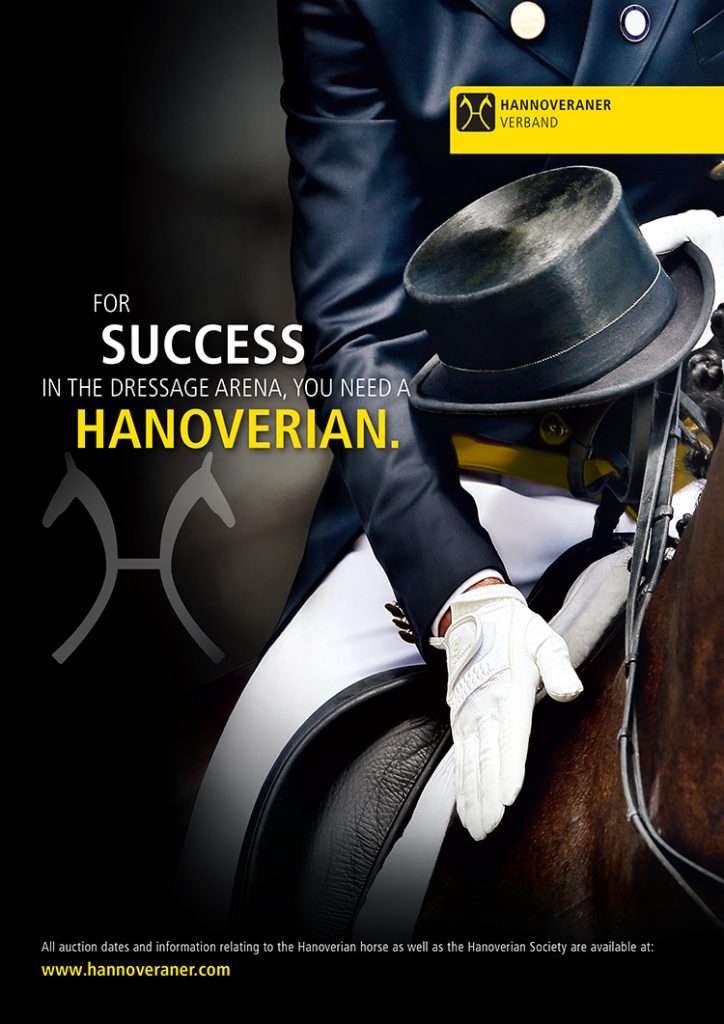 “If you want to make the circle smaller, you tell your helper on the horse, open your inside rein and make the circle smaller, and at the same time you shorten your lunge, and the horse associates the lunge, which he knew, with the rein opening. That is the language of your aids, that is fundamental to start everything. By the correctness of the lunging, and the side reins, we can start to establish contact, establish the rhythm, the relaxation, establish all the first phase of the scale on the lunge. You are able to work on suppleness, rhythm, contact because the horse accepts the contact with the very long side reins, he doesn’t get upset with the side reins because they are steady and not the rider jerking on top, because if the horse is not trained, he is a bit unbalanced and the rider can become a bit unbalanced too. On the lunge we have no problem with no rider on top and the horse can learn to accept the contact.”
“If you want to make the circle smaller, you tell your helper on the horse, open your inside rein and make the circle smaller, and at the same time you shorten your lunge, and the horse associates the lunge, which he knew, with the rein opening. That is the language of your aids, that is fundamental to start everything. By the correctness of the lunging, and the side reins, we can start to establish contact, establish the rhythm, the relaxation, establish all the first phase of the scale on the lunge. You are able to work on suppleness, rhythm, contact because the horse accepts the contact with the very long side reins, he doesn’t get upset with the side reins because they are steady and not the rider jerking on top, because if the horse is not trained, he is a bit unbalanced and the rider can become a bit unbalanced too. On the lunge we have no problem with no rider on top and the horse can learn to accept the contact.”
“On the lunge we start with the cavesson only, and later you put on the bridle and the side reins. On the lunge we can start to mobilise the croup a little around you, and then with the rider on the back of the horse, the rider uses the aids of the shoulder-in, and the trainer on the ground with the cavesson and the whip, makes him do what he had already done without the rider, then when the rider goes to ride the horse on his own, the horse can straight away do the beginning of a shoulder-in.”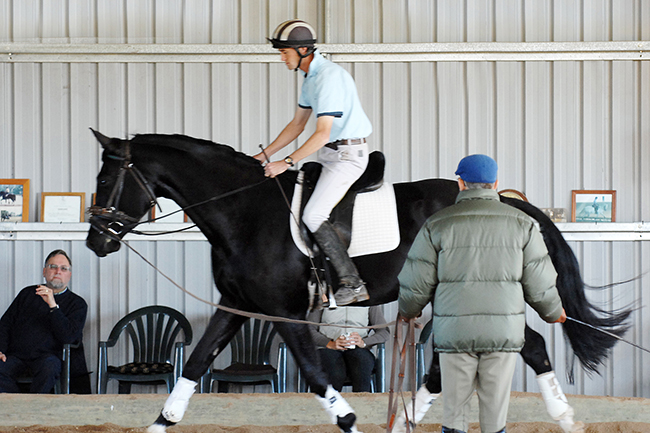
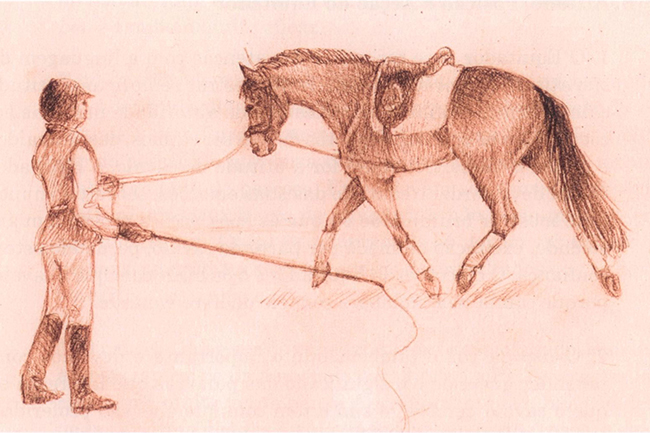
“The lunge is the way to introduce yourself to the horse, to establish the first communication of your aids. With the lunge and the whip, we make the horse go forward, you make the horse slow down, lengthen the stride, come to you, make a little bend.”
“The first thing on the lunge is to have the horse balanced on the circle, not falling in, not falling out. At the beginning he can be excited, to avoid excitement, I hold the lunge rein while my helper holds the rein and walks with the horse a big circle, little by little the helper comes away from the horse and leaves it on its own, and the horse learns to go. When he goes on the circle, he starts to relax, then you start to move him forward and ask for some bend, and the horse by himself, starts relaxing and getting the rhythm. He starts to balance and get confident and gets the rhythm straight away, because nature makes the horse rhythmic – what we are trying to do is get the horse to work like he does when he is free.”
“So we start to work on a few transitions, developing going forward, making the circle smaller or bigger, achieving lateral suppleness. We start to get engagement, not collection of course, but engagement is one element of collection, and we can achieve that by making the circle smaller and bigger. The training scale is there from the beginning.”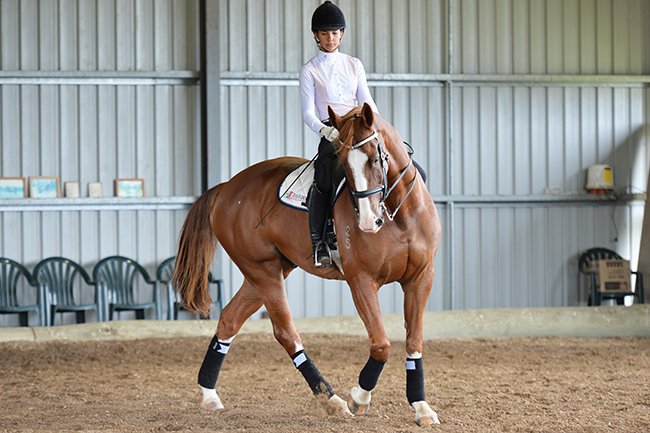
Ok, we have trained the horse to work on the lunge, we’ve had the rider on the horse, still on the lunge, now the horse and rider are going free – what are the exercises that you want to start with…
“Just make him go forward, circles, go large, circle, go large. Use the circle to control because the horse remembers the lunge, ride a few diagonals. On the first rides we are just getting the horse confident and accepting the contact with long reins. Very simple exercises. And when you feel the horse is getting confident, then, helping on the ground, some shoulder-in at the walk at the end of the session. Be careful to put the horse away when you have achieved what you want…”
In the early stages do you want the rider in a light seat?
“Normal seat. It is a bit difficult to find ‘light seat’, I don’t like the term. People say, it is a light seat because I come off the saddle, but unless you have a pair of wings, you never take the weight off the saddle because your weight is on the stirrups, the stirrups are connected to the saddle, the saddle is on the back of the horse, your weight is still on the back of the horse. But you can shift your weight a little forward in the saddle, and perhaps then you are not banging on the back of the horse. Rising trot is what I call light seat. Light seat means to me, don’t use too much your weight aids to make a circle or make a downward transition, because the horse doesn’t understand yet. Just connect with the movement with your weight and with your body, that connection is enough to later on make the horse accept the weight.”
Is it important to start with a rider who is secure and balanced?
“It is fundamental. At the very first stage, the rider has to do as little as possible – at the beginning when the trainer holds the lunge, the rider is almost a robot, just a weight to go with the movement, and disturb the horse as little as possible. The rider should be very connected with the movement, very confident and show that he is relaxed, because when you are relaxed, the horse feels that straight away. His instinct is to go with what the other animal does, so we need quite an advanced rider.”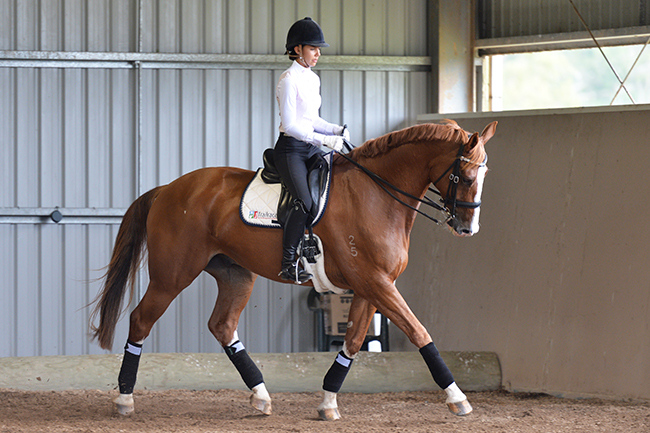
What are the first school figures that you use?
“Once the horse goes forward and on the circle and I am not needed on the ground, I start riding the horse. The only reason for the trainer to start on the ground is that he needs to control with the whip and the lunge, and that needs an experienced trainer who knows if the horse is not going forward because he is frightened or stiff, because then if you go to push, the horse goes to buck and jump out of the arena. You need a lot of experience to know how to work with the whip on the ground. Once the horse is accepting the weight and going forward, the trainer gets into the saddle.”
“When I start riding it is a lot of transitions in the rising trot, the basic gait is the trot. Just a bit of walk, not too long walks because the horse can become excited, or unconfident in the walk. Short lessons, rising trot, increasing the trot a bit, circles, serpentines, changing diagonals. When the horse starts to accept the contact and understand the legs to go forward, little by little start decreasing the circle, sitting the trot, rising trot, short periods of rising trot, sit again. To make the horse understand the sitting trot, and not to panic. Start to introduce the shoulder-in and later on, counter shoulder in and all the lateral exercises.”
At what stage do you introduce your little circle around the forehand?
“Very much at the beginning, after about one week. I can start it because I have done this work in hand on the ground. I put my leg on the girth, I bend the horse, turn around sideways…”
“At this stage, what is very important is to be able to read the horse. To understand that every horse is different, and some horses understand quicker than others – mental factors, physical conditions, problems of conformation. Temperament is associated with conformation, because if by conformation your horse is not comfortable, he will become tense. You have to assess straight away if the horse has conformation problems, because he will become tense, because it is not easy for him to do what you are asking. Sometimes they have perfect conformation and they still have tension issues. First of all you have to think that each horse is an individual. Just because your previous horse could start shoulder-in after ten lessons, this one can do the same – it might take much longer. What I can guarantee you, and it is the experience of many years, is that you gain a lot of time by waiting. I remember a horse that I trained a long time ago, and the canter was too difficult to control, so I spent months just in the trot, and then the first time I started riding him in canter, I could ask for the start of half passes and counter canter. But if I had started the canter earlier I would have been in trouble because the canter was so difficult to control. Of course I lunged him in the canter, but I could see if I tried to ride him it would be a fight in the canter, so I did all the work in the trot.”
“With Grace’s horse, at the beginning, we didn’t try to do much in the canter, just around and around, because in trot you can establish and create the control. After you have that control, you have a better chance to canter well.”
“Lateral work starts as an exercise of loosen up, circles, shoulder-in on the circle, becoming more engaged with the shoulder-in on a straight line, transition shoulder-in to walk, the start of collection. Transitions into medium trot, to improve impulsion because that creates the flexibility and the engagement behind to go forward. Flexibility creates impulsion, impulsion is nothing more than flexibility – the horse is willing, because he is able to do what you are asking because he is flexible. I can collect more because it is a lateral exercise, the half halt passes through the horse and the horse understands better that you want him to collect – he can collect without resistance. Again, with the lateral work you are moving to the stage on the scale which is collection.”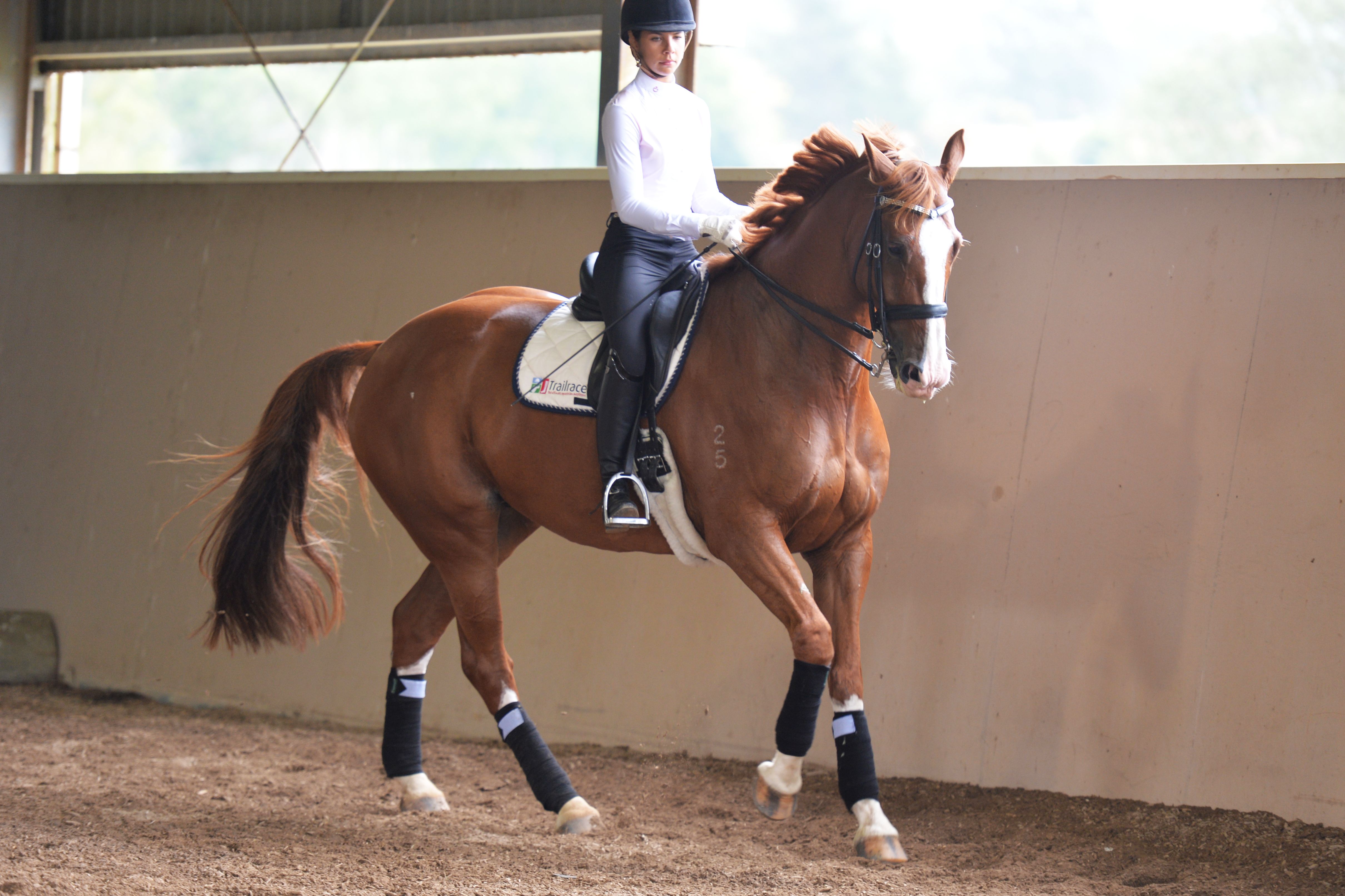
“With Grace’s horse, at the beginning, we didn’t try to do much in the canter, just around and around, because in trot you can establish and create the control. After you have that control, you have a better chance to canter well.”
The impulsion and the extended paces come from…
“The flexibility, the balance: with suppleness your horse becomes flexible. We have to distinguish between impulsion, and forward, they are connected, but not the same. The first time I ask the horse to go forward and to respond to my legs, and sometimes he needs to go a little faster, but he has to learn to go from the legs, and if he loses rhythm, bad luck, but he has to learn to go from the legs. With the development of flexibility and suppleness, that going forward becomes impulsion, because impulsion in equitation is a horse that is willing to move forward, in the correct balance and rhythm and the correct outline, this happens when the horse is flexible. Impulsion is nothing more than the ability of being supple and of being flexible. Flexibility to go forward, and to collect. There is as much impulsion to go from an extended trot to collected trot, perhaps more impulsion to come to the true collected trot without just slowing down the trot, perhaps more impulsion on the down transition than the up transition, because up transition is instinct for the horse to go, the down transition is not so instinctive, we have to create this more.”
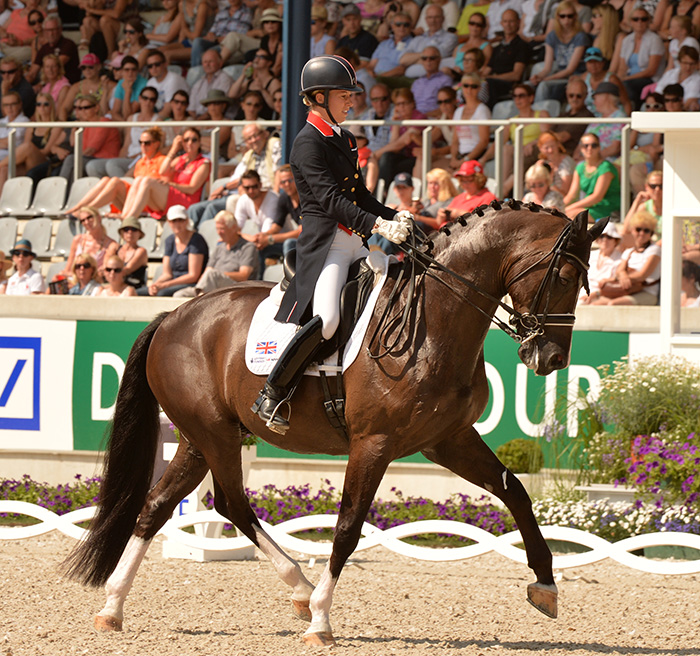
“Flexibility is ease of movement, look at Valegro, how easy it is for him to move, he is floating, he is elastic. And because he is comfortable in these movements, he is relaxed mentally. If you are in school and it is exam time, and when you go to the exam there is an idiot of a teacher supervising, very rough and gruff, you start the exam already a bit timid. If you sit in the class and everything is relaxed, then everything you have studied comes to your mind easier. If the horse is comfortable, it relaxes his brain, if he is not comfortable, he thinks, let me out of here. You see it with his tail.”
“Sometimes people say my horse tries hard – very nice, when they say that, I say your horse ‘looks’ like it tries hard, but it is only because he is very good, very well trained, and you are riding very well, and that might look like the horse is trying hard but he doesn’t have any reason to try hard – his instinct for self preservation makes him do what is comfortable, but he is not trying anything.”
What does the frame look like?
“From the balance horizontal with the transitions, I begin starting collection, that the horse goes more up in front, because he needs to flex more his hindquarter, so his neck comes up, and he lowers behind.”
“In the end, the horse is in what I call the vertical balance – he really lowers his hindquarter, comes really up in front, and really flexes behind, and he is collected.”
“It is very simple to train a horse. You make him active behind, from the activity behind you create flexibility on the poll, when the horse is flexed on the poll, you do nothing and the activity behind becomes engagement, and after you have engagement, you make a half halt and you have the horse collected and he is trained. Very simple!
It is very important to understand that collection is not a stage that your horse stays in – it is a stage where the horse can go in, and come out, because if he stays in, and won’t come out, it is not collection, it is squashed. What we see very often in Grand Prix is horses jammed in front, by being jammed in front the horse gets an engagement.
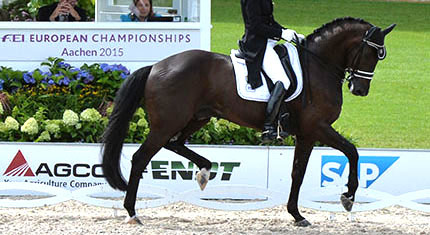
But the judges are looking for how many centimetres the horse comes off the ground with the hind legs, and if the horse leans on his forehand, he comes more off the ground. If I lean on my hands, it is easy for me to lift my feet – it is the same with the horse.
You see horses like Valegro they do it in the right way, and do it very well. It is not just Valegro, he is very good, fantastic, he is very well trained, but there are lots of horses that can be trained on the correct way. But it is much quicker to jam the horse in front, and the horse, because he is squashed behind, he comes up with his legs – but it is not what I like.”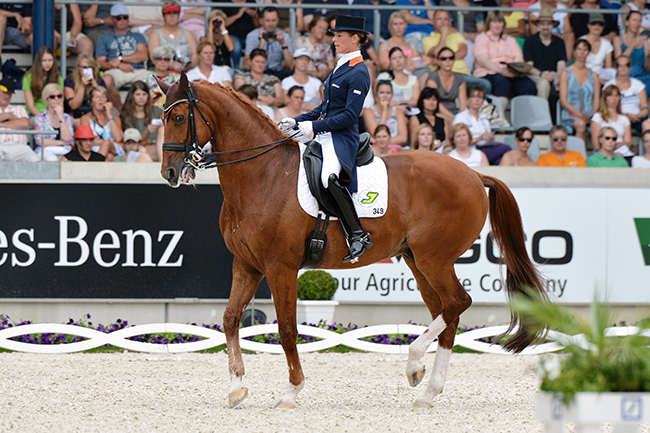
“What we see very often in Grand Prix is horses jammed in front, by being jammed in front the horse gets an engagement and the piaffer is absolutely horizontal.”
What about the great Dutch discovery that if you pull the horse’s head down and in and behind the vertical, his back would come up and he could move more…
“Like everything in life, it is partly true. No doubt, if you arch his neck down without jamming, I don’t see anything bad about that, and in the training, we make a lot of exercises that I call round and down. If I put the horse behind the vertical when I ask the horse to stretch his neck down, he doesn’t shorten his neck, and this creates engagement. When you put your horse round and down, he instinctively balances himself, and then you feel your contact is light, and his head is down, and his back is working well. In the beginning, and always after a very good collecting exercise, it is very good to have the horse round and down because when he comes up in the collection, he puts pressure on his loins, pressure on his back, to release that pressure, put him down and round.”
“That is nothing to do with jamming the head back, it’s a releasing and a stretching after the collection. You stretch the horse, but you don’t force the horse into an outline and stay on and on in that shape. Down and round is fundamental in training the horse, but it must be done in the correct way – when they are jammed, they don’t stretch, they are squashed. You could see that with one horse that was very fashionable, everything was jammed, squashed, very ugly, it is against nature. You don’t even need to know about horses, to know that when you look, you don’t like it.”
There are squashed horses but usually with riders who go behind the vertical and drive their horses forward…
“The weight is so much in their hands, that if they did not lean back they would be catapaulted off the horse. Pull back, pull back, from the front end is just wrong. Okay there is some degree because we have to flex the poll to create engagement behind, but it is nothing to do with jamming the neck. Jamming is pulling back.
Round and down, we invite the horse to go down. Nothing to do with the nose on the chest – when the horse’s nose is on its chest, the half halt does not go past the wither, it does not pass to the hindquarter, and that is what I want. It’s easy to create jerky movements from behind by kicking with the spur or hitting with the whip, but it is not the correct activity behind that we want.”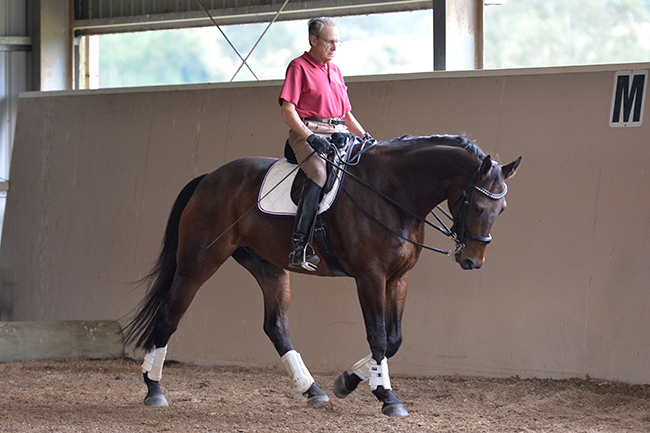
“You stretch the horse, but you don’t force the horse into an outline and stay on and on in that shape. Down and round is fundamental in training the horse, but it must be done in the correct way – when they are jammed, nothing, they don’t stretch, they are squashed.”
Why is it that 75% of dressage riders, ride with that ugly leaning back seat?
“75? Maybe 95? Because it is much quicker to get the result, the judges can’t see, they give good marks, and that’s it.”
Not because they cannot balance in the middle of the saddle and the movement?
“I don’t believe so, it is not very difficult to learn how to balance in the saddle. I was in the army and I trained a lot of men who had never seen a horse before, and very quickly they learnt to sit. I think it is just because pulling and jamming their horses, the horses do what they are obliged to do, and they get the results very quickly.”
But it does seem that for the rider to be able to sit in that nice position with his legs and arms relaxed, the horse has to be in balance, it is a circle between the rider and the horse and the horse and the rider…
“Of course, when you look at the statues of the kings and the generals, the horses are all collected, and then the rider goes very easily to the correct position – make a piaffer and you are very quickly sitting correctly. The horse invites you to go to the correct position. But you have to have the correct position even on the young horse because if you are not in a correct position, if your aids are not independent, then you go against the movement, you created more inbalance, then the horse is already feeling with the weight of the rider. The correct position is fundamental to a connection to the movement, to not disturb the horse, and to be able to use your aids at the correct moment, and in the correct way.”
Contact just comes?
“Contact is a result. Everything in training the horse is to achieve the correct combination of balance and impulsion. You can’t have balance without impulsion, or impulsion without balance. If you have correct balance and correct impulsion, you have the contact. It happens.”
“Self carriage is when the horse is so well trained and so comfortable, that the rider has to do as little as possible to keep that balance, and keep that impulsion… the horse carries himself without the constant help of the rider.”
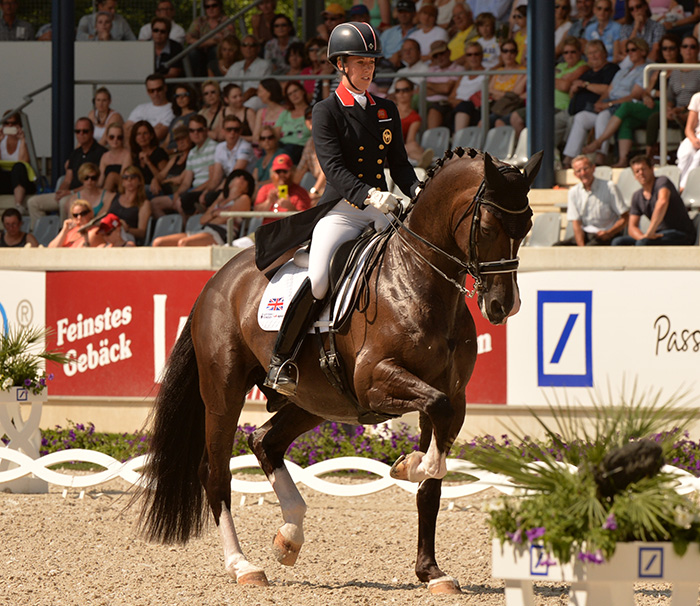
“Self carriage is when the horse is so well trained and so comfortable, that the rider has to do as little as possible to keep that balance, and keep that impulsion… the horse carries himself without the constant help of the rider.”
What are the exercises you use to achieve collection?
“All lateral work. You can make a shoulder-in on the rising trot forward, that is a good suppling exercise, from that rising trot forward, you sit and collect the trot, and you have a good exercise to collect the trot, to start the collection. Transitions. Travers, renvers, half pass, the advantage of the lateral work is, you collect the horse by the half halt. When your horse is on the lateral movement, he is more supple, he is looser, he is already very well balanced, and so you can dramatically improve the collection. Travers / renvers / passage / travers / renvers / piaffe. By going from one side to the other you mobilize the horse, engage, engage, engage, lower the croup, and there is the collection.”
“When you start the lateral work with diagonal aids – which means the horse is looking in the direction of the movement, which means the half pass, the travers and the renvers – the horse immediately, when he bends and moves in the direction of the bend, he engages more the inside hind leg, and he has to engage even more the outside hind leg to cross over. If you go on the shoulder-in, you are only engaging the inside hind leg, so you don’t get the degree of engagement that comes with travers, renvers.”
“Another thing that is very important because it causes a lot of confusion, and that is, one of the elements of collection is engagement. When the horse does piaffer, he is much more engaged than when he makes extended trot, isn’t he? But the horse engages much more the hind legs in extended trot, than in piaffer – so the engagement is not only a characteristic of the collection. The way the horse uses that engagement is what establishes the degree of collection. If he engages and pushes, like in the piaffe, the weight only upwards, then forward is much more the collection. When you make an extended trot, the length of the stride is the same as the length of stride in the piaffer, but in the piaffe the trajectory is up not forward. Engagement of the piaffer, the horse flexes more all the joints of the hindquarter, than he flexes in the extended trot, but in the extended trot he flexes too, but not so much up and down. Up and down establishes what is collected, and what is not. You can make a shoulder-in in working trot and the horse covers more ground, but when you make the shoulder-in in collected trot, the stride comes up and you develop more the collection. The degree of elevation that the engagement creates, is what tells you the degree of collection the horse has achieved.”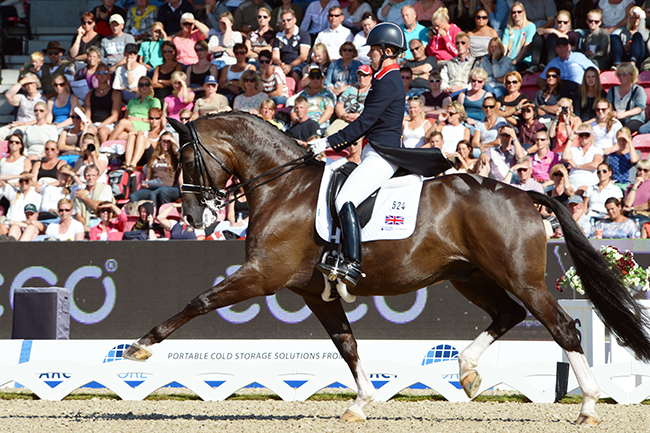
“When you make an extended trot, the length of the stride is the same as the length of stride in the piaffer, but in the piaffe the trajectory is up not forward. Engagement of the piaffer, the horse flexes more all the joints of the hindquarter, than he flexes in the extended trot, but in the extended trot he flexes too, but not so much up and down.”
Does that require more balance?
“It is a different balance. The vertical balance where the horse has more weight behind, more free in front, and he goes more up and down on the spot, and covers less ground. It’s two things, the engagement of the hind legs and the engagement of the hindquarter. The hindquarter is also engaged and goes down – engaged NOT squashed. Squashed is when the horse only flexes the joints behind, the hocks and the fetlocks, and the croup really doesn’t lower.”
“The maximum of collection is the levade when the horse only pushes upwards, and the piaffer is the preparation. But nowadays, because the horses are bred to do it, they can make a piaffe leaning on the forehand. Remember Nicole Uphoff and Rembrandt, the horse leans on the forehand with the croup up and up – but the judge just looks at the hooves with an imaginary tape, ten centimetres, score – 8, seven centimetres – 7, six centimetres – 6. But that is what happens, the judge doesn’t know what piaffe is, and just looks how high the hooves come up, and the riders have to do that to get the marks. If the horse leans a bit forward, it comes more off the ground – and thus the horse can do piaffer without being collected, almost without being collected. You see many horses now, the croup is coming up, instead of flexing down and up they go up and down, it could be the same thing but it is not. Go up because you went down, not down because you went up! That’s the difference.”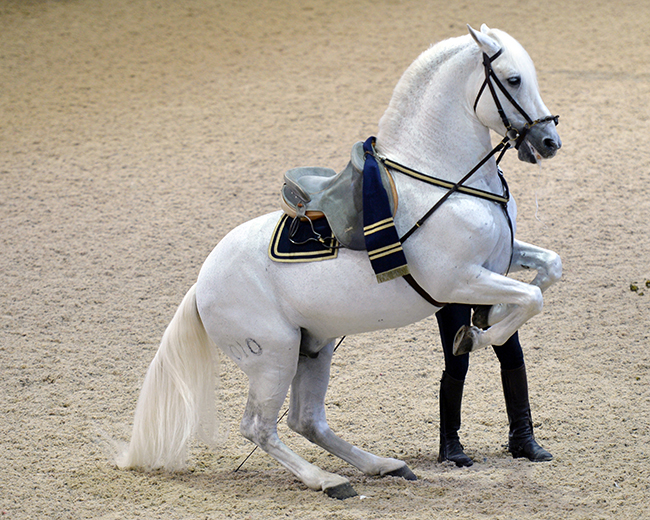
“The maximum of collection is the levade when the horse only pushes upwards, and the piaffer is the preparation. But nowadays, because the horses are bred to do it, they can make a piaffe leaning on the forehand.”
When I listen to you, it all sounds so simple and so easy, but how do I reconcile this with the fact that so much of the dressage I see is so ugly and unpleasant – and then I see Grace do it, and suddenly it does look easy and beautiful… what is happening?
“It happens because of the lack of correct training, correct preparation. Nowadays horses are much more made by the breeders, they are the ones who should have the gold medal because the horse comes already with such talent and ability, that the riders ask and they do – but they ask the wrong way, or sometimes in the right way, but they don’t have the preparation for the right way. Even if they start doing it the right way, sooner or later they find an easier way.”
“The idea of the preparation is to make it easier for the horse to do the work – by the gymnastics, the correct progression. Training should be progressive, logical and gradual and consistent. If the horse is prepared, then it is comfortable and becomes better and better and better. Valegro for instance, I am sure when he started, he was not as expressive as he is now, but with the training, the gymnastic, the correct sequence of exercises, he got stronger and that natural ability could explode in the right way and the expression is there.”
“Another big mistake, is because the judges always mark highly expression, they ask for the expression without the preparation. They forget the training scale, the regularity of the steps – if the horse becomes irregular because he is not strong on both sides, he becomes uncomfortable and it shows. Like you said, it needs to look easy…”
But Grace’s horse is not an incredibly naturally talented horse…
“Not at all, he is a very big horse and not very strong, all the strength he has now was created step-by-step. He grew up very quickly, a lot of mass but no muscles. The expressive trot he has now, if he had not been prepared, he would be exploding and running away. He does not cope so well with pressure – remember the first flying change she did, Grace got bucked off.”
Yet now he looks so calm…
“Because he is confident. No doubt his spook is very genetic, he is always seeing great big lions and his instinct is to flee, now he is comfortable and instead of seeing seven lions, he sees one lion, very small, and he doesn’t spook.”
And the rider is exceptional – world class exceptional…
“Absolutely. She has everything that a trainer / coach wants, and allows the coach to take risks, to ask in the correct way, but sometimes to take a risk when we are sure the horse is correctly prepared because I know she never over-does it, she knows where to stop.”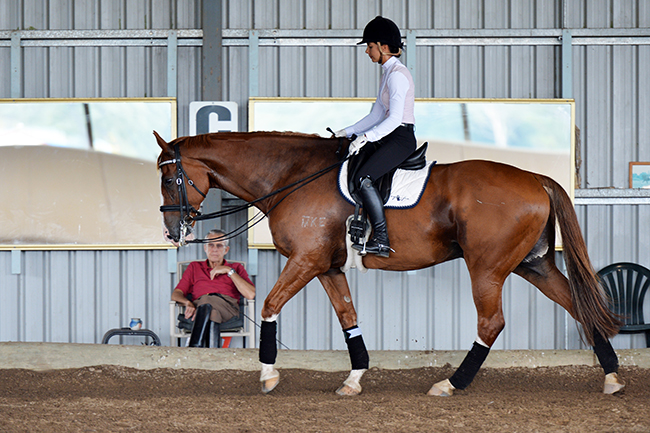
That was interesting today in the shoulder-in, travers, when he was getting a little wide behind and you were asking Grace to ride shallow shoulder-ins and travers…
“To be sure that the inside hind leg of the horse is always close to the outside leg, and not too far out or in, and not taking the weight of his body, because he tries to do that all the time – she needs to ride very well to control that, it is because she is riding well, not because the horse is offering it. She has such focus and attention and that is what she has been born with…”
Breed a dressage star – what’s available in Australia? Go to www.ihb.com.au and be surprised – how about Foundation? or Fürstenball. Winners themselves, and producers of winners in Europe
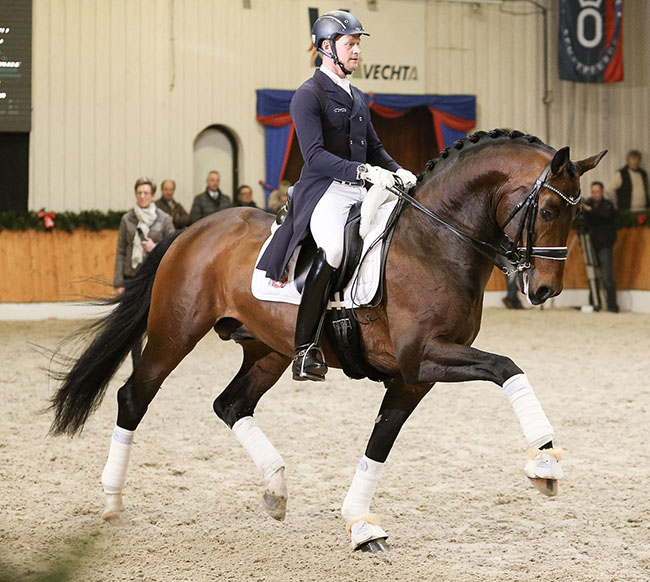
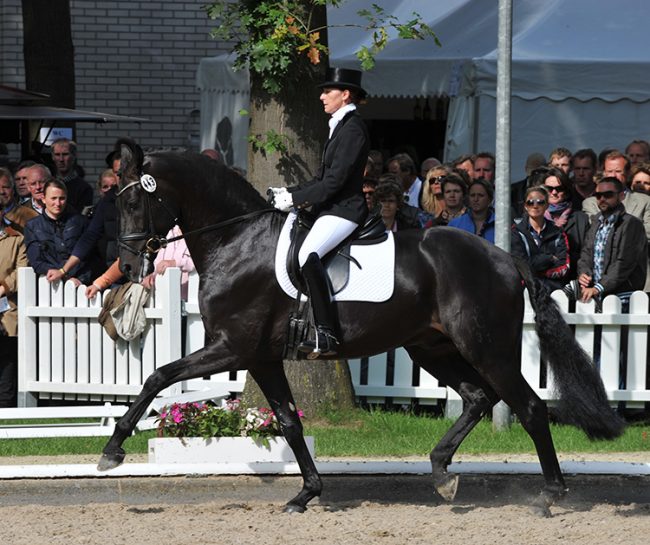

One thought on “Miguel Tavora – Horseman, Thinker, Teacher…”
Comments are closed.